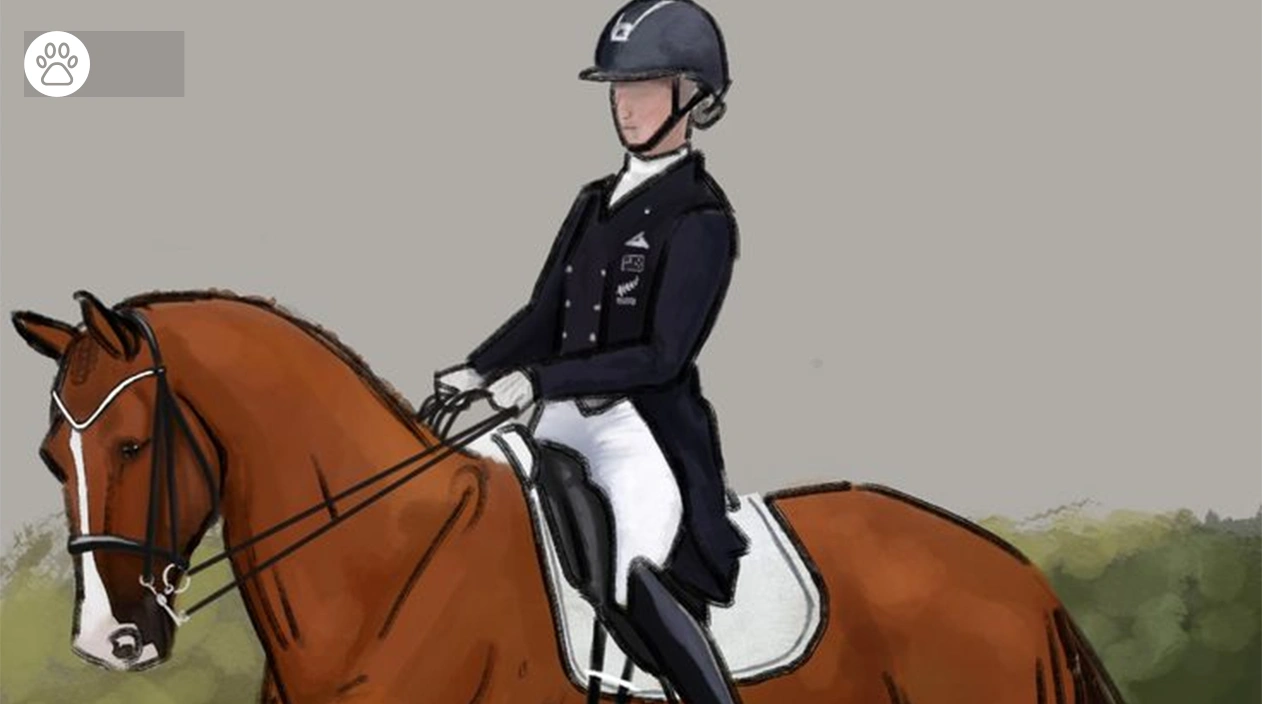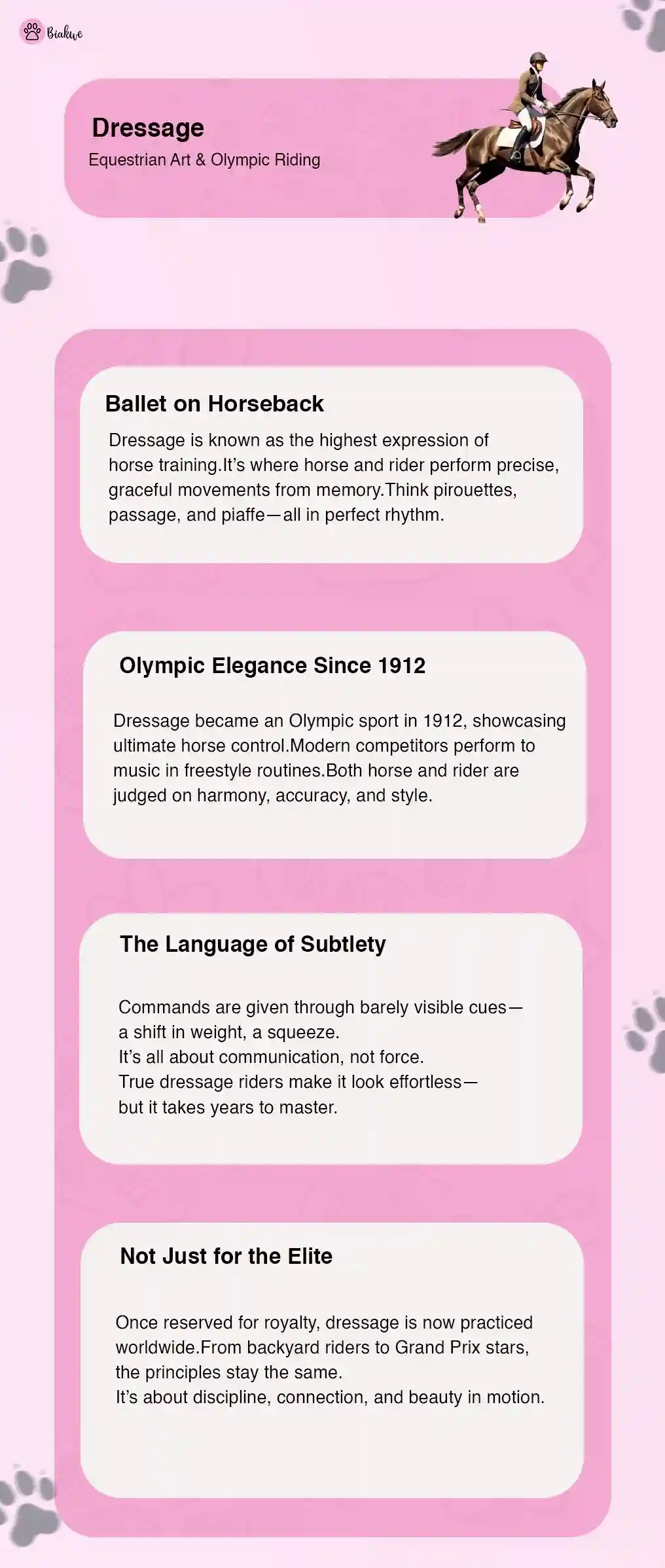Consider a dressage performance where a horse and rider are a perfectly synchronized unit. Each step is executed with both precision and grace, showing off a multitude of maneuvers. It is no wonder that dressage is often referred to as “horse ballet”; however, what happens behind the scenes is even more fascinating.
What Is Dressage?
In simpler terms, dressage is the French word for “training,” and as a discipline, it focuses on the intricate connection of a horse and rider, capturing their coordinated dance made from a concrete set of “tests”. These tests are composed of the movements the horse is capable of performing, paired with his or her eager attitude shaped from a plethora of training.
Learn More Horse related blogs at our website.
A horse’s flexibility, responsiveness, and balance are put into focus, these being key factors needed for the horse to seamlessly execute daily activities along with competitive tasks. This orderly training makes and elevates horse riding into an art form, marking the peak of equestrian training.

The History of Dressage
The classic dressage techniques find their relevance in well-structured military training routines done back in the centuries where agile tactical movements and synchronised show of horse riding were integral elements of infantry.
It gained popularity in riding schools in Europe during the 16th century when focus was put on honing a horse’s natural skills. By the mid-1900s, the holistic sport had gained popularity with centrally mandated regimes, with distinct tests riding emerged.
What Is Dressage Olympics
It made its Olympic debut in 1912 and has since retained its position as one of the core disciplines, along with show jumping and eventing. It is often considered the most artistic and refined of the three as it describes the bond between horse and rider at a different level.
The Olympic tests require precision, grace, and smooth flow of movement in every action taken.
The competition is split into three distinct parts. The riders compete in the Grand Prix as a qualifying round, where it is required to perform a specified series of advanced movements.
The Grand Prix Special comes next, where they perform a short but technically demanding version of the previous round with less margin for error.
Last but not least, Grand Prix Freestyle showcases the riders’ creativity with pre-selected music as they develop their own choreography to these tunes, thereby fusing sport with performing arts.
This last round is loved by the audience as it displays a unique level of control and creativity that goes beyond mere riding and speaks to the relationship between the horse and rider.
Visit: Weiner Dogs: Price, Breeds, and Mini Dachshund Costs
Understanding Dressage Movements
A horse’s training, athleticism, and obedience are showcased through carefully subdivided movements that form a test. Below are some of the key movements you’ll see in a competitive dressage.

Piaffe
A piaffe is often described as a highly collected and performed trot in place. It displays the horse’s strength, balance, and the ability to place weight on their hindquarters. It captures a horse’s ability to self-carry and maintain control brilliantly.
Passage
Passage is slower, elevated trot, and performed with pronounced rhythm. The foot strike appears to almost float mid-air whilst keeping elasticity, power, and grace contained.
Extended Trot
During the extended trot, the horse increases its stride without changing the beat. This demonstrates the horse’s strength, ability to bend, and grace when it comes to stride length control.
Flying Changes
While cantering, the horse may perform a flying change, which consists of changing the leading leg. This skill shows agility, balance, and quick responsiveness. Usually, these movements are done in sequences for added complexity.
All of these movements require small but precise aids from the rider, which shows the trust and partnership the rider and horse share.
Discover: American Robin Bird Facts: Diet, Nesting, Lifespan and Symbolic Meaning
The Dressage Horse
Many people have a question: What is a dressage horse? The answer is here
Each horse fulfills its purpose differently, and only a small fraction of horses will be able to compete in dressage. Outstanding physical skills and aptitude for the specifics of a graceful movement sequence are crucial, along with specific mindset traits and attributes.
At the top tiers of the discipline, prerequisites such as a harmonious gait, movement deviation, collection, suspension, responsiveness to fine signals, and subtle rider hints make riding difficult.
Most horses not designed for furious gallops or races are bred specifically for focus traits. It enables them to respond to commands bred over centuries. These traits have emerged in numerous elite breeds claiming global dominance.

Top Breeds For Dressage
Dutch Warmblood
The Dutch Warmblood is one of the most elegant breeds in the discipline of dressage horse riding. This horse is bred in the Netherlands and is well-known for its striding power, intelligence, and willingness to be trained.
With regard to height and proportions, the Dutch Warmblood is a horse of medium size and sophisticated refinement. It’s internationally competing Dutch Warmbloods that so often succeed at international competitions because of their powerful moving attributes and mastery of expression in the show ring.
Hanoverian
The Hanoverian originates from Germany, where its practical power, nobility, and steady temperament are sought. Hanoverians score high for their smooth movement as well as natural and constant bias for extension, which makes them ideal candidates in the equestrian dressage world. Advanced or novice riders alike appreciate the help of Hanoverians.
Oldenburg
Another striking German breed is the Oldenburg, admired for its powerful outline, carriage, and expression of movement. Oldenburgs possess a particular elegance of stride combined with the presence of adjust, hardness, or calmness under pressure that gives them sure success in the dressage arena.
Explore: Red Headed Woodpecker: Habitat, Diet and Fun Facts
Training and Equipment
What is dressage without proper training? The training develops both the physical capabilities of a horse and the technical skills of a rider. It requires patience, meticulous planning, and long-term devotion.
Key Equipment
It is done right with the appropriate tack and attire. They are important not just for looks, but for comfort, control, and performance.
Dressage Saddle
A rider has a correct position and can contact the horse while communicating precisely. It causes the horse to respond to the rider’s cues. A saddle has a deeper seat and longer, straighter cut flaps.
Double Bridle
Without the enhanced control and subtle communication offered in a double bridle, high-level riding is next to impossible. Having two sets of reins enhances nuanced communication, especially for advanced dressage riding.
Protective Boots
While not utilized during competitions, protective boots are the basic requirement for everyday work. They aid in shielding a horse’s legs from knocks during corrective work on demanding movements like passage and piaffe, as well as in training sessions.
Dressage Today
As modern dressage evolves, it still manages to uphold some practices. Video analysis and motion sensor technology do make it easier for one to refine their technique. In addition, there is a greater focus on the welfare of the horses, which ensures ethical training methods.
With the likes of Charlotte Dujardin and Isabell Werth, dressage has received a great deal of attention, which has inspired many aspiring equestrians.
The Essence of Dressage
What is dressage if not the culmination of a partnership? Pins or medals, calm arena or theatrics of the Olympics— in dressage, every detail matters in the choreography of the horse and its rider’s non-verbal communication. It is simultaneously historical, progressive, and artistic.
Through commitment to training alongside the correct horse and equipment, the precision and artistry of discipline enable mastery. It transforms riding into an equestrian art form.
